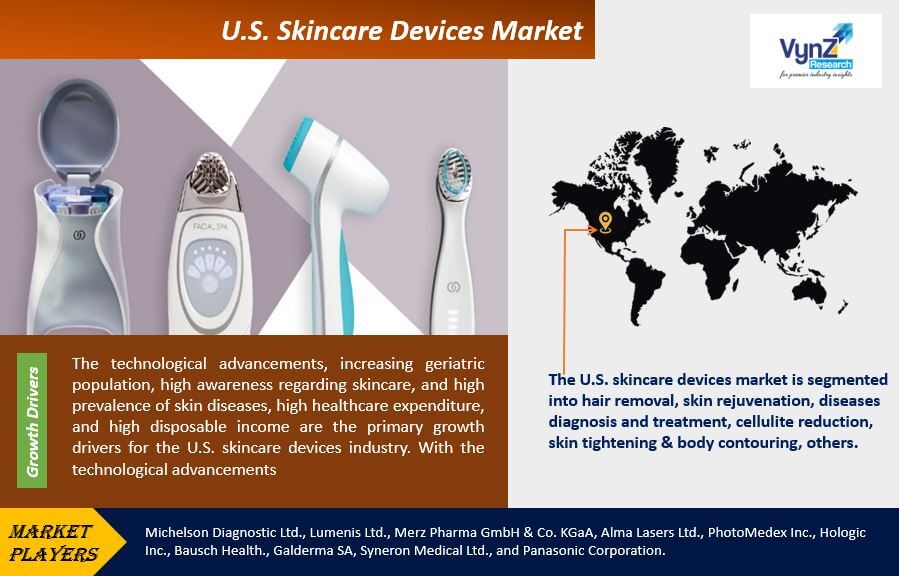Industry Overview
The U.S. Skincare Devices Market is expected to grow at a CAGR of 11.2% during the forecast period with its market size predicted to reach USD 5.8 billion by 2030. The U.S. skincare devices market is primarily driven by factors such as technological advancements, an increasing geriatric population, high awareness regarding skin care, and a high prevalence of skin diseases. Laser-based devices, electrosurgical devices, light-based devices, and liposuction devices are the major contributor to the skincare devices industry in the region.

Market Segmentation
Insight by Type
Based on the type, the skincare devices market is categorized into treatment devices and diagnostic devices. Treatment devices are majorly used in comparison to the diagnostic devices and contribute larger revenue for market players. Skincare treatment devices market is categorized into laser-based devices, electrosurgical devices, light-based devices, liposuction devices, microdermabrasion, cryotherapy devices, and others. Of all these devices laser devices market is predicted to observe the highest growth during the forecast period.
Diagnostic skincare devices market is further segmented into biopsy devices, dermatoscopes, image-guided systems, and others. Of all these diagnostic devices, image-guided systems market is anticipated to observe the highest CAGR during the forecast period.
Insight by Distribution Channel
On the basis of the distribution channel, the skincare devices market is segmented into direct channels and indirect channels. Skincare devices are more sold through indirect channels as compared to direct channels, however, with the increasing internet penetration market players are also leveraging the benefits of direct channels.
Insight by Application
On the basis of application, the U.S. skincare devices market is segmented into hair removal, skin rejuvenation, diseases diagnosis and treatment, cellulite reduction, skin tightening & body contouring, others. The highest growth for skincare devices is predicted to be observed for skin tightening and body contouring application.
Insight by End User
The primary end users of skincare devices in the U.S. are dermatology clinics, spas and salons, hospitals, and others. Among all end users, the spas and salons are expected to witness the fastest growth in demand for the skincare devices in the U.S. With the technological advancements, and high awareness among consumers, the demand for these devise in spas and salon is anticipated to grow significantly in the coming years.
U.S. Skincare Devices Market Report Coverage
|
Report Metric
|
Details
|
|
Historical Period
|
2018 - 2023
|
|
Base Year Considered
|
2024
|
|
Forecast Period
|
2025 - 2030
|
|
Market Size in 2024
|
U.S.D. xx.x Billion
|
|
Revenue Forecast in 2030
|
U.S.D. 5.8 Billion
|
|
Growth Rate
|
11.2%
|
|
Segments Covered in the Report
|
By Type, By Distribution Channel, By Application and By End User
|
|
Report Scope
|
Market Trends, Drivers, and Restraints; Revenue Estimation and Forecast; Segmentation Analysis; Impact of COVID-19; Companies’ Strategic Developments; Market Share Analysis of Key Players; Company Profiling
|
|
Regions Covered in the Report
|
U.S.
|
Industry Dynamics
Growth Drivers
The technological advancements, increasing geriatric population, high awareness regarding skincare, and high prevalence of skin diseases, high healthcare expenditure, and high disposable income are the primary growth drivers for the U.S. skincare devices industry. With the technological advancements, the skincare devices are portable, easy to use and cheaper which leads to their higher adoption among the different end users.
The geriatric population is prone to several skin problems such as acne, wrinkles, aging spots, and hair loss. This leads to an increased demand for treatment and diagnostic skincare devices. For instance, 47.8 million people were aged 65 or above in the U.S. in July 2015, representing 14.9% of its total population. Also, the population of people aged 65 and older in the U.S. is projected to reach 98.2 million in 2060.
The demand for premium brands of skincare devices is observed to remain high in the U.S. The high disposable income in the U.S. leads to high affordability of the technologically advanced skincare devices in the country. For instance, as per the World Bank data, the GDP per capita of the U.S. was USD 37,273.6 in 2001, which increased to USD 59,531.7 in 2017.
Challenges
The high cost of equipment and some of the side effects associated with the devices are the key challenges faced by the U.S. skincare devices industry. The side effects associated with the devices leads to major concern among consumers, thus, hampering the growth of the market.
Competitive Insight
Some of the players operating in the U.S. skincare devices industry are Michelson Diagnostic Ltd., Lumenis Ltd., Merz Pharma GmbH & Co. KGaA, Alma Lasers Ltd., PhotoMedex Inc., Hologic Inc., Bausch Health., Galderma SA, Syneron Medical Ltd., and Panasonic Corporation.
Industry Segmentation
The U.S. Skincare Devices Market report offers a comprehensive market segmentation analysis along with an estimation for the forecast period 2025–2030.
Segments Covered in the Report
- By Type
- Diagnostic
- Biopsy Devices
- Dermatoscope
- Image Guided System
- Others
- Treatment
- Laser-Based Devices
- Electrosurgical Devices
- Light-Based Devices
- Liposuction Devices
- Microdermabrasion
- Cryotherapy Devices
- Others),
- By Distribution
- By Application
- Hair Removal
- Skin Rejuvenation
- Diseases Diagnosis and Treatment
- Cellulite Reduction
- Skin Tightening & Body Contouring
- Others
- By End-User
- Dermatology Clinics
- Hospitals
- Spas and Salons
- Others
PRIMARY RESEARCH INTERVIEWS - BREAKDOWN
%20System%20Market.png)




%20System%20Market.png)